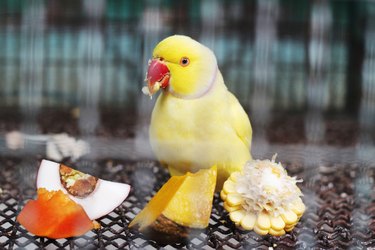
Indian ringneck parakeets, otherwise known as rose-ringed parakeets, are easily bred in captivity. This makes for a great amount of literature about the breeding habits of these small, colorful parrots. Genetic sex testing will allow beginning breeders to assure themselves of juvenile birds' sex prior to the black ring showing up around the male's neck, which marks sexual maturity in these birds. Females do not have the ring.
Female Specific Behaviors
Video of the Day
Female Indian ringneck parakeets are angry, boisterous birds that will kill their mate if the female decides she dislikes him. Supervision must be constant with birds that are not constantly caged together due to this predatory, territorial instinct in female birds. Female ringnecks that are ready for breeding will crouch and tilt their heads back to entice males caged near them. When the male is introduced, even interested females can decide to chase the male around the cage and torment him for a short period of time. If the female does not calm down, try moving the pair to a cage neither of them has been in before.
Video of the Day
Male Specific Behaviors
During the breeding season, sexually mature males will be ready to mate with any willing female. Bowing and staring at female birds caged near him are two steady signs that a male wants to breed with a particular female. If the female and male are kept together year-round, the pair will become far more affectionate with one another. This includes grooming each other, nestling on the same perch and making noises much like cooing.
Nesting
Female birds, or cages with a pair of constantly caged-together birds, require a nesting box. One of the first signs that a female is ready and interested in breeding is that she will begin to nest. This includes behaviors such as digging around in the box, carrying seed into the box or attempting to pluck their human owner's hair to store in the box later. If the female is not seen nesting, but there are bits of paper or seeds in her nesting box, she is probably getting ready to start nesting.
Injuries And Solutions
Male birds are often injured during attempts of mating. Females are savage toward their mates and tolerate very little from them. Giving the birds a break from each other and removing the male from the situation can help to calm a very upset female down. If the male is very badly injured or if there is any blood at all, take the bird to a veterinarian.